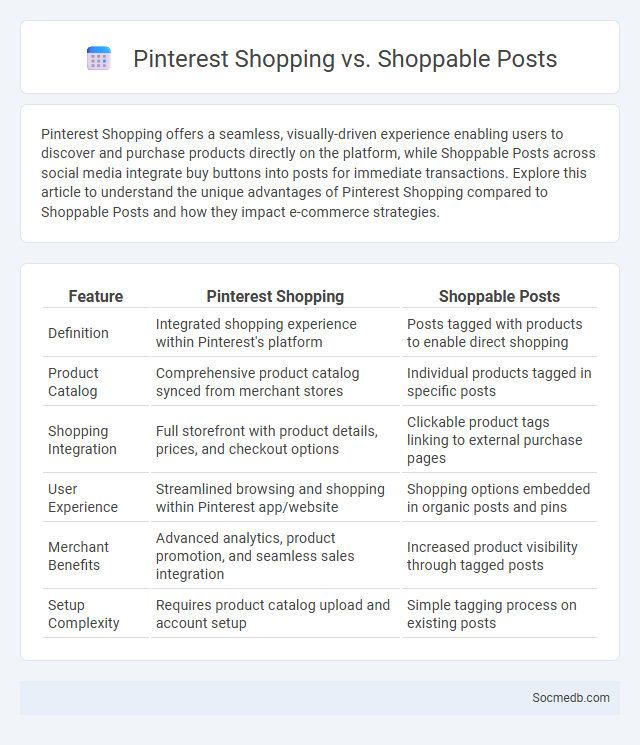
Photo illustration: Pinterest Shopping vs Shoppable Posts
Pinterest Shopping offers a seamless, visually-driven experience enabling users to discover and purchase products directly on the platform, while Shoppable Posts across social media integrate buy buttons into posts for immediate transactions. Explore this article to understand the unique advantages of Pinterest Shopping compared to Shoppable Posts and how they impact e-commerce strategies.
Table of Comparison
| Feature | Pinterest Shopping | Shoppable Posts |
|---|---|---|
| Definition | Integrated shopping experience within Pinterest's platform | Posts tagged with products to enable direct shopping |
| Product Catalog | Comprehensive product catalog synced from merchant stores | Individual products tagged in specific posts |
| Shopping Integration | Full storefront with product details, prices, and checkout options | Clickable product tags linking to external purchase pages |
| User Experience | Streamlined browsing and shopping within Pinterest app/website | Shopping options embedded in organic posts and pins |
| Merchant Benefits | Advanced analytics, product promotion, and seamless sales integration | Increased product visibility through tagged posts |
| Setup Complexity | Requires product catalog upload and account setup | Simple tagging process on existing posts |
Introduction to Social Commerce Platforms
Social commerce platforms integrate e-commerce functionality directly into social media networks, enabling seamless shopping experiences where users can discover, research, and purchase products without leaving the app. These platforms leverage user-generated content, social interactions, and personalized recommendations to drive engagement and sales. Your success on social commerce depends on understanding key features like shoppable posts, influencer collaborations, and live-stream shopping events.
Overview of Pinterest Shopping
Pinterest Shopping integrates visual discovery with e-commerce, allowing users to explore and purchase products directly from Pins. Merchants benefit from features like Product Pins, personalized recommendations, and shoppable catalogs that enhance user engagement and drive sales. The platform leverages rich metadata and image recognition to optimize product visibility and streamline the shopping experience.
What Are Shoppable Posts?
Shoppable posts are social media content that allows users to purchase products directly through embedded links or tags. These posts integrate product information, prices, and a call-to-action button, streamlining the e-commerce experience within platforms like Instagram, Facebook, and Pinterest. Brands leverage shoppable posts to increase conversion rates by reducing friction between product discovery and purchase.
Exploring Shopping Integration Features
Social media platforms increasingly integrate advanced shopping features such as Instagram Shopping, Facebook Shops, and TikTok Shopping, enabling seamless product discovery and purchase within the app. These features leverage AI-driven recommendations, shoppable tags, and in-app checkout to enhance user engagement and boost e-commerce sales. Businesses benefit from real-time analytics and targeted advertising, driving personalized marketing strategies directly through social media channels.
Key Differences Between Pinterest Shopping and Shoppable Posts
Pinterest Shopping integrates a visual discovery platform with direct product listing features, allowing users to browse and purchase items seamlessly within the Pinterest app, while Shoppable Posts primarily appear on platforms like Instagram and Facebook as clickable posts linking to external e-commerce sites. Pinterest Shopping emphasizes personalized recommendations based on user interests and search behaviors, enhancing product discovery through curated boards and trends. Shoppable Posts rely heavily on influencer content and real-time social interactions, creating an immediate, social-driven purchasing experience distinct from Pinterest's discovery-centered approach.
Advantages of Native Shopping Integration
Native shopping integration on social media platforms enhances user experience by allowing You to make purchases directly within the app, reducing friction and increasing conversion rates. This seamless shopping process leverages advanced targeting algorithms to deliver personalized product recommendations, boosting engagement and sales. Brands benefit from increased visibility and streamlined customer journeys, driving higher revenue and improved customer satisfaction.
User Experience Comparison: Pinterest vs Other Platforms
Pinterest offers a unique user experience centered around discovery and inspiration through visual content, distinguishing it from platforms like Instagram and Facebook, which prioritize social interaction and real-time updates. The platform's intuitive image categorization and personalized feed enable you to effortlessly explore ideas and projects, enhancing engagement and content relevance. Compared to other social media, Pinterest's focus on visual search and idea curation provides a more organized and goal-oriented user journey.
Impact on Conversion Rates and Sales
Social media platforms drive significant increases in conversion rates by enabling targeted advertising and personalized user engagement. Your brand benefits from real-time customer insights and interactive content that boost purchase intent and shorten sales cycles. Research shows companies leveraging social media experience up to 20% higher conversion rates compared to traditional marketing channels.
Choosing the Best Shopping Solution for Your Brand
Selecting the best shopping solution for your brand on social media hinges on integrating seamless e-commerce features like Instagram Shops or Facebook Marketplace that align with your target audience's preferences. Prioritize platforms offering robust analytics and customizable storefronts to enhance user experience and drive conversions. Leveraging tools that support direct purchasing, detailed product showcasing, and secure payment options maximizes sales potential while reinforcing brand credibility.
Future Trends in Social Shopping Integrations
Social shopping integrations are transforming e-commerce by blending social media platforms with seamless buying experiences, leveraging augmented reality and AI-driven personalized recommendations. Platforms like Instagram, TikTok, and Facebook are enhancing in-app shopping features to increase user engagement and conversion rates, supported by data analytics and influencer partnerships. Emerging trends highlight the rise of live shopping events and social commerce ecosystems, making future social shopping more interactive and data-centric.
 socmedb.com
socmedb.com